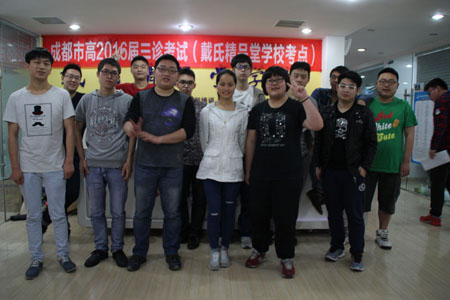
1. canteen can t 2. washroom music room
3. shirt skirt 4. rainy windy
5. shoes shorts 6. cheap sneakers
7. carrots horses 8. 10:15 10:50
( ) 5. A. There are 50. B. They re 50 yuan.
1.( )A.sheep B.cheap C.lamb D.hen
2.( )A.eleven B.thirteen C.fifteen D.fresh
3.( )A.c
( )(2) How many people are there in your family?
loudy B.socks C.sunny D.warm4.( )A.lunch B.dinner C.breakfast D.carrot
5.( )A.gym B.TV room C.washroom D.boot
6.( )A.shoes B.pants C.socks D.wear
7.( )A.red B.colourful C.green D. white
rice ( ) wall ( ) aunt ( )
nice ( ) what ( ) ant ( )
( ) 1. A. table B. shelf C. house
( ) 2. A. fan B. fat C. quiet
( ) 3. A. thirty B. first C. forty-one
( ) 4. A. farmer B. sports C. nurse
( ) 5. A. short B. soup C. rice
1. classroom 2. Turn on the light. 3. listen to music
4. science 5. do sports 6. Set the table.
Come and meet my family. This is my (爸爸),he s a
(老师). This is my (妈妈), she s a (医生). She likes (牛奶)and s ( 鸡蛋). Look at this (男孩), he s my (哥哥). And this (女孩)is me. I m a
(学生). We all like (牛肉). We have many s(朋友)here. I love my family.
( )3. 想帮妈妈干活,说: C. How many pencils do you have?
Mike is an English boy. He s ten. His sister s name is Mary. She s five. She is not a student. Mike has a new schoolbag, but not heavy. There are some books in it. They re Chinese book, English book and math book. There is a black and red pen in his pencil-case. He likes the pen very much.
1.rice 2. wall 3. ant 4. spoon 5. paint
My schoolbag is heavy. What s in it? 16 books, 8 rulers, 24 crayons, 12 erasers and 35 sharpeners.
1. May I have a look? (D) 2. What s for dinner? (A)
3. What s your father? (B) 4. Where is your seat? (E)
六、1. Ww Yy 2. Ff Hh 3. Tt Uu 4. Jj Ll 5. Nn Oo
九、father , teacher , mother , doctor , milk , egg , boy , brother , girl , student , beef , friend
3. today it warm . 4. ducks are they ?
Mike: There are many carrots and potatoes. I like cucumbers. They are fresh. I don t like onions. They are smelly.
5. Where are my shoes? Look! They re under your bed.
预习也叫超前学习,是指在教师上课之前,对所要学习的内容提前进行学习和理解的过程。预习既是有效的学习方法,也是良好的学习习惯。预习的方法是对第二天要讲授的内容认真阅读,仔细思考,把新的知识和以往学过的知识联系起来,看看哪些懂了会了,哪些不懂不会,从而明确听课的重点、难点和疑点,克服课堂学习过程中的被动性和盲目性,提高主动性和自觉性,以利于提高学
三至五年级,语文的转折时期,阅读、作文等重量级的内容成为了孩子必须掌握的题型,也真正开始了语文的综合能力考验,在此阶段有了前两年的会话写话的习惯基础,就很容以进入深一层的学习状态。从3年级开始,可以开始让孩子阅读一些较长的文集小说,是否完全理解不是关键,关键是能在较长的文字中抓住中心和有用信息。因此,在阅读之前最好给孩子提出一至两个能够让孩子连贯上下文关系,抓住文章中心的问题。这一方面是阅读题型的训练,另一方面是作文的材料。其次,作文方面,平时积累素材是关键但不是全部。针对考试作文题型,如果不是文采非凡的孩子,还必须掌握一套写作技巧,在此框架上提高自己的作文水平。作文是孩子最容易出问题,也最难以把握的语文考题,在平时课堂训练的时候,老师如果不能针对每个孩子的写作风格加以提点及训练,孩子的作文水平很难提高。
习效果。C.分母能被2和5整除的分数肯定能化成有限小数
A. Wh
1、Here you are. Thank you.___________________
2. Whats in your schoolbag?
_。er s Miss Green.看我一脸疑惑的样子,王大伯拿起一根剪下的枝条,笑了笑,对我说:“你别看这根枝条长得粗壮,其实它只吸收营养,不结果实。这种枝条不剪掉,到了春季就会
师:走到哪儿都带,都到哪儿了?
疯长起来,把许多养分夺走。”接着,王大伯抚摸着那些留下的枝条,充满信心地说:“来年就靠它们结桃子啰!我将信将疑:剪去这些枝条,来年真的能长出更多更大的桃子吗?











 关注官方微信
关注官方微信
 关注官方微博
关注官方微博




